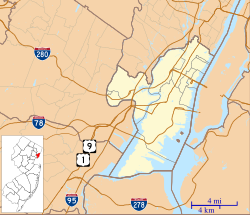Church of the Holy Innocents | |
 | |
| Location | Willow Avenue and 6th Street, Hoboken, New Jersey |
|---|---|
| Coordinates | 40°44′38″N74°2′1″W / 40.74389°N 74.03361°W |
| Area | 0.8 acres (0.32 ha) |
| Built | 1885 |
| Architect | Edward Tuckerman Potter; Henry Vaughan |
| Architectural style | Gothic, Shingle Style |
| NRHP reference No. | 77000871 [1] |
| NJRHP No. | 1460 [2] |
| Significant dates | |
| Added to NRHP | May 24, 1977 |
| Designated NJRHP | February 4, 1977 |
The Church of the Holy Innocents was an Episcopal church at Willow Avenue and 6th Street in Hoboken, Hudson County, New Jersey, United States. The congregation was founded in 1872. [3] It was built 1885 to the designs of Edward Tuckerman Potter and Henry Vaughan. The choir was added in 1913, the baptistery in 1932. [4] It was added to the National Register of Historic Places in 1977. It is no longer in use as a church but the building remains.


